Passing seams and sides
2019-12-24
Ben Raymond, Adrien Ickowicz, Mark Lebedew.
Some volleyball scouting software (notably DataVolley) allows the details of the reception action to be recorded: whether the receiver took the ball on their platform or hands, and if it was on the platform, whether they took the ball on their left, mid-line, right, or low. What can we use this information for?
We’ll explore some ideas using data from the men’s 2016/17 Italian Superlega. Each diagram shows the percentage of passes and expected sideout percentage (a measure of pass quality), across those categories: pass by platform (look for the “Mid” and “Low” labels on the y-axis of each figure) or hands (“Overhand”), and for platform passes whether it was left, mid-line, or right.
By serve type
First, looking only at passes made by liberos, broken down by serve type (jump serve or jump-float serve):
Jump serve reception
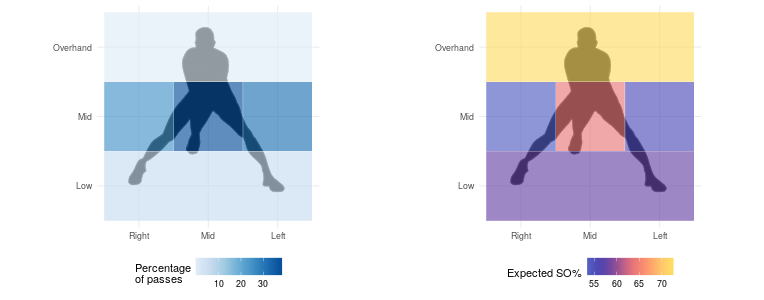
Jump-float serve reception
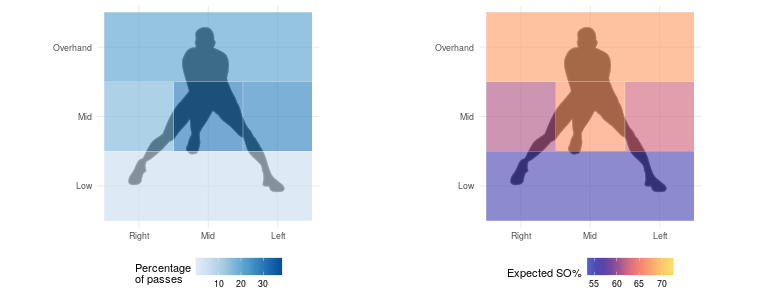
| Serve type | Reception side | N receptions | % of passes | Error % | Perfect pass % | Efficiency % | Expected sideout % |
|---|---|---|---|---|---|---|---|
| Jump serve reception | Low | 305 | 6.1 | 11.1 | 40.3 | 32.5 | 58.1 |
| Jump serve reception | Middle line | 1855 | 37.4 | 3.2 | 39.7 | 41.3 | 64.0 |
| Jump serve reception | On left | 1534 | 30.9 | 12.1 | 24.1 | 14.1 | 55.1 |
| Jump serve reception | On right | 1219 | 24.5 | 13.3 | 22.4 | 9.9 | 53.9 |
| Jump serve reception | Overhand | 31 | 0.6 | 0.0 | 83.9 | 87.1 | 72.1 |
| Jump-float serve reception | Low | 143 | 5.7 | 9.8 | 33.6 | 22.4 | 55.4 |
| Jump-float serve reception | Middle line | 738 | 29.4 | 1.4 | 51.8 | 55.7 | 66.7 |
| Jump-float serve reception | On left | 681 | 27.1 | 4.8 | 40.1 | 40.5 | 62.6 |
| Jump-float serve reception | On right | 408 | 16.3 | 6.4 | 36.3 | 37.3 | 61.2 |
| Jump-float serve reception | Overhand | 525 | 20.9 | 1.5 | 57.5 | 61.5 | 67.4 |
Not surprisingly, jump serves are almost exclusively passed on the platform whereas around 20% of jump-float serves are passed with the hands. In both cases, also not surprisingly, platform passes from the mid-line had a higher expected sideout percentage (i.e. better quality passes) than those made on the right or left. This effect was stronger with jump serves (about 10% lower expected sideout percentage when passed on left or right compared to mid-line) than jump-float serves (about 5%).
By court position
Does it matter which position the receiver is in on court? Generally, the libero will pass from the right-hand side of the court (position 1) when the setter is in P2, P4, or P5, and pass from the middle of the court (position 6) when the setter is in P1, P3, or P6.
Firstly for jump serve reception:
Jump reception in position 1
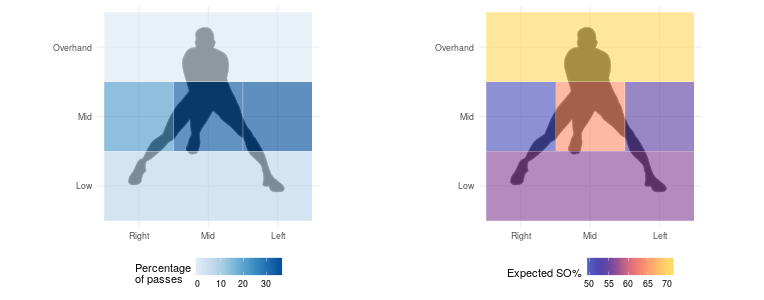
Jump reception in position 6
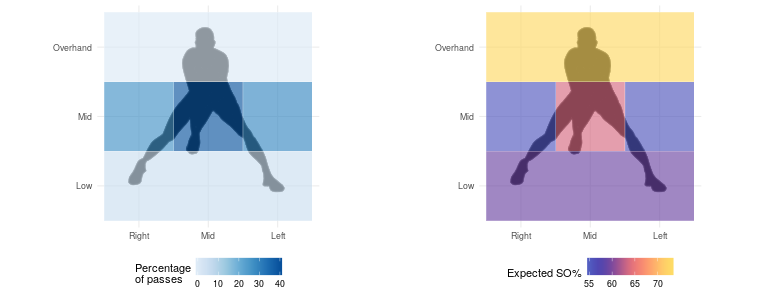
When receiving in position 1, fewer passes were made on the receiver’s right. Most passes were made on the mid-line or the libero’s left (i.e. the seam between the libero and the pass-hitter to their left, assuming a three-person receiving formation). When receiving in position 6 (i.e. with the libero between the two pass-hitters) there were no obvious differences in the number or quality of passes made on the left compared to the right
And for jump-float reception:
Jump-float reception in position 1
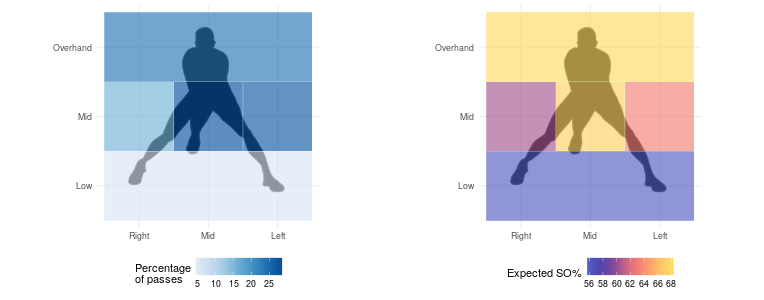
Jump-float reception in position 6
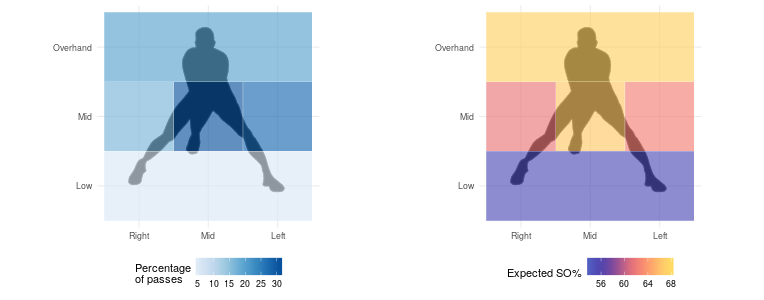
| Serve type | Libero passing in | Reception side | N receptions | % of passes | Error % | Perfect pass % | Efficiency % | Expected sideout % |
|---|---|---|---|---|---|---|---|---|
| Jump serve reception | 1 | Low | 137 | 2.8 | 12.4 | 38.7 | 28.5 | 56.5 |
| Jump serve reception | 1 | Middle line | 617 | 12.4 | 2.8 | 39.2 | 42.3 | 64.4 |
| Jump serve reception | 1 | On left | 635 | 12.8 | 13.2 | 25.0 | 13.9 | 54.3 |
| Jump serve reception | 1 | On right | 385 | 7.8 | 17.9 | 19.5 | 1.6 | 50.7 |
| Jump serve reception | 1 | Overhand | 8 | 0.2 | 0.0 | 75.0 | 75.0 | 70.5 |
| Jump serve reception | 6 | Low | 168 | 3.4 | 10.1 | 41.7 | 35.7 | 59.3 |
| Jump serve reception | 6 | Middle line | 1238 | 24.9 | 3.5 | 40.0 | 40.8 | 63.7 |
| Jump serve reception | 6 | On left | 899 | 18.1 | 11.3 | 23.5 | 14.3 | 55.6 |
| Jump serve reception | 6 | On right | 834 | 16.8 | 11.2 | 23.7 | 13.8 | 55.4 |
| Jump serve reception | 6 | Overhand | 23 | 0.5 | 0.0 | 87.0 | 91.3 | 72.7 |
| Jump-float serve reception | 1 | Low | 54 | 2.2 | 11.1 | 37.0 | 33.3 | 56.2 |
| Jump-float serve reception | 1 | Middle line | 259 | 10.3 | 0.4 | 54.1 | 57.5 | 67.3 |
| Jump-float serve reception | 1 | On left | 251 | 10.0 | 6.0 | 47.0 | 47.8 | 63.2 |
| Jump-float serve reception | 1 | On right | 147 | 5.9 | 7.5 | 34.7 | 34.7 | 60.3 |
| Jump-float serve reception | 1 | Overhand | 218 | 8.7 | 1.4 | 62.4 | 65.1 | 67.8 |
| Jump-float serve reception | 6 | Low | 89 | 3.5 | 9.0 | 31.5 | 15.7 | 54.9 |
| Jump-float serve reception | 6 | Middle line | 479 | 19.1 | 1.9 | 50.5 | 54.7 | 66.4 |
| Jump-float serve reception | 6 | On left | 430 | 17.1 | 4.2 | 36.0 | 36.3 | 62.3 |
| Jump-float serve reception | 6 | On right | 261 | 10.4 | 5.7 | 37.2 | 38.7 | 61.7 |
| Jump-float serve reception | 6 | Overhand | 307 | 12.2 | 1.6 | 54.1 | 59.0 | 67.1 |
Fewer passes were made on the the receiver’s right in both positions. Also, the pass quality in position 1 was slightly lower when receiving on the right (expected sideout rate of 60.3%) compared to the left (63.2%) or mid-line (67.3%). When receiving in position 1 against float servers, many liberos will tend to take responsibility for a larger area of the court. This gives less passing responsibility to the front-row pass-hitter, hopefully allowing them more opportunities to attack without having to pass first. However, our results suggest that serves to the libero’s right hand side (i.e. towards the sideline in position 1) might yield poorer passes, perhaps because the libero has a larger court area to cover.
A mini case study
To finish off, let’s look at Modena’s main pass-hitters from the 2016/17 season: Earvin Ngapeth and Nemanja Petric. Ngapeth normally played next to the setter (i.e. in position 2 when the setter was in 1), with Petric far from the setter (in position 5 when the setter was in 1). This means that in P4 and P5, Petric would be on Ngapeth’s left when receiving. In P2, Petric would be receiving on Ngapeth’s right. (In the other rotations P1, P3, and P6, the two pass-hitters are separated by the libero in position 6 when receiving.)
Against jump serves, we see these patterns for Petric:
Petric: jump reception in P4
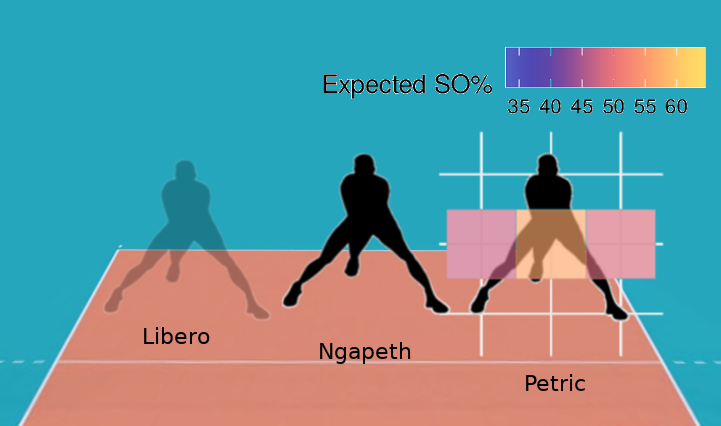
Petric: jump reception in P5
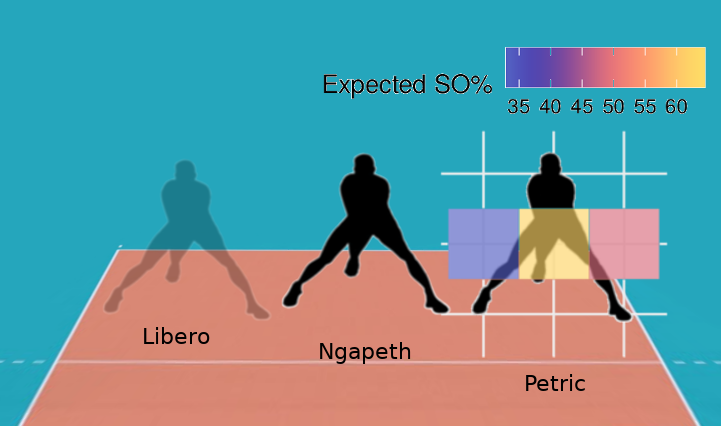
In P4 (with Petric receiving on the left of Ngapeth), Petric’s pass quality was not noticeably different when receiving on his right compared to his left. However, in P5 (also with Petric receiving on the left of Ngapeth), Petric’s pass quality was lowest when receiving on his right. In P2 when Petric was to Ngapeth’s right, his pass quality was poorest when receiving on his left.
Petric: jump reception in P2
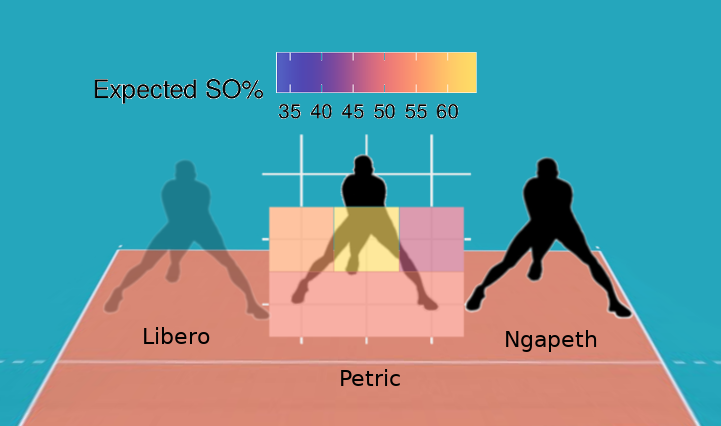
These particular results are based on a relatively small data set (30–50 passes in total for each of those three rotations) and so should be treated with caution. Nevertheless, might the seam between these two players have been a weakness in the team’s reception?
Conclusion
Patterns such as this might help you find passing weaknesses in opposition teams, or your own. The posture plotting functionality can be found in this app.
